AUCTORES
Globalize your Research
Research Article | DOI: https://doi.org/10.31579/2694-0248/050
1 Assistant professor of Orthopedics and Traumatology, Faculty of Medicine, Al-Azhar University, Egypt.
2 Professor of Orthopedics and Traumatology, Faculty of Medicine, Mansoura University, Egypt.
3 Professor of Orthopedics and Traumatology, Faculty of Medicine, Al-Azhar University, Egypt.
4 Assistant lecturer of Orthopedics and Traumatology, Faculty of Medicine- Al-Azhar University, Egypt.
5 Lecturer of Orthopedics and Traumatology, Faculty of Medicine- Al-Azhar University, Egypt.
*Corresponding Author: Barakat El-Alfy, Professor of Orthopedics and Traumatology, Faculty of Medicine, Mansoura University, Egypt
Citation: Ibrahim E. Abuomira, Barakat El-Alfy, Mahmoud Seddik, Khamis M. Ahmed, Sayed Khashaba, et al, (2023), A Modified Angled Plate for Fixation of Proximal Femoral Varus Osteotomy in Paralytic Hip Dislocation, J. Clinical Orthopedics and Trauma Care, 5(1); DOI:10.31579/2694-0248/050
Copyright: © 2023, Barakat El-Alfy. This is an open access article distributed under the Creative Commons Attribution License, which permits unrestricted use, distribution, and reproduction in any medium, provided the original work is properly cited.
Received: 29 September 2022 | Accepted: 26 December 2022 | Published: 07 January 2023
Keywords: proximal femoral osteotomy; cannulated interlocking blade plate; modified angled blade plate; paralytic hip dysplasia
Objectives: Femoral osteotomy is an important step in the management of paralytic hip dysplasia. Fixation by the angled plate is demanding and carries the risk of many complications. In this study, we made certain modifications for the angled plate, and we aim to assess the results of the modified plate for fixation of proximal femoral varus osteotomy in paralytic hip dysplasia.
Method: Twenty patients with paralytic hip dislocation were included in this study. The ages ranged from 5 to 15 years with an average of 9 years. There were 12 boys and 8 girls. Seventeen patients had cerebral palsy and 3 had meningocele disease. Pre-operative radiographs were done, and the migration percentage (MP), acetabular index (AI), and neck-shaft angle (NSA) were measured. All patients were treated by open reduction, pelvic osteotomy, and proximal femoral varus osteotomy. The femoral osteotomy was fixed by the modified angled plate in all cases.
Results: The osteotomy sites united in all patients and the average time of union was 3 months. The acetabular index, migration percentage, and neck-shaft angle were reduced postoperatively. This reduction was statistically significant. The hips remained stable throughout the period of follow-up in all patients. No cases were complicated by nonunion or implant failure.
Conclusion:
The modified angled plate (canulated interlocking blade plate 90°) is a good method for the fixation of proximal femoral varus osteotomy in the management of paralytic hip dislocation. The modifications have made it easier for application and stable for fixation.
Hip affection in children with cerebral palsy (CP), Myelomeningocele, and other neuromuscular disorders range from the hip at risk to frank dislocation with significant affection for the patient quality of life [1-3].
Early surgical management of paralytic hip dislocation brings benefits to patients, by reducing their pain, improving their sitting position, and facilitating their hygienic measures. The goal of surgical treatment is to ensure that the femoral head is located perfectly in its anatomical position, without risk of dislocation. This is usually done by soft tissue release, open reduction, and proximal femoral varus osteotomy with or without pelvic osteotomy [4-6]. The pelvic osteotomy technique described by Dega that corrects anterior, lateral, and posterior acetabular deficiencies is widely accepted for the treatment of paralytic hip dysplasia [7].
The bone quality in such patients is usually poor and fixation of the proximal femoral osteotomy by the conventional angled plate is difficult and carries the risk of mal tracking, loosening, and implant failure [8, 9].
In this study, we introduced certain modifications for the cannulated angled plate, and we hypothesized that this new system would offer significant advantages over the existing systems in terms of easy application and stable fixation.
The aim of this study is to assess the results of the new modified plate for fixation of proximal femoral varus osteotomy in paralytic hip dislocation.
In this prospective study, 20 cases with paralytic hip dislocation were treated in our institution in the period between May 2016 and August 2020. The ages ranged from 5 to 15 with an average of 9 years. There were 12 boys and 8 girls. The mean weight of the patients was 21.9 kg (range 14–31.5 kg). The pathology was cerebral palsy in 17 cases and myelomeningocele in three cases.
Patients were evaluated clinically for the range of movement, leg length discrepancy, muscle power, and unilateral or bilateral affection. Plain radiographs were done for both hips and the acetabular index (AI), migration percentage (MP), and neck-shaft angle (NSA) were measured (Figure. 1) [10].
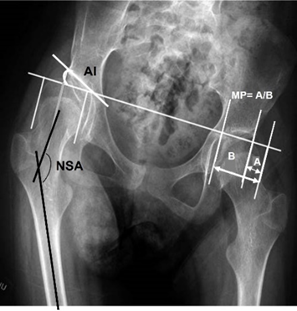
Figure 1: Theacetabular index (AI), migration percentage (MP), and neck-shaft angle (NSA) are measured.
Preoperative planning for hip reduction and femoral osteotomy with or without pelvic osteotomy was done.
The cannulated angled plate was modified in certain ways to be more stable for fixation (Figure. 2).

Figure 2-a: The profile of the plate was decreased from 4.5 to 3.5 and the 2nd angle of the plate was reduced from 42.5° to 20°.

Figure 2-b: An inter-fragmentary 3.5 locked screw was designed from the shaft of the plate to the blade in an oblique direction by 30°.
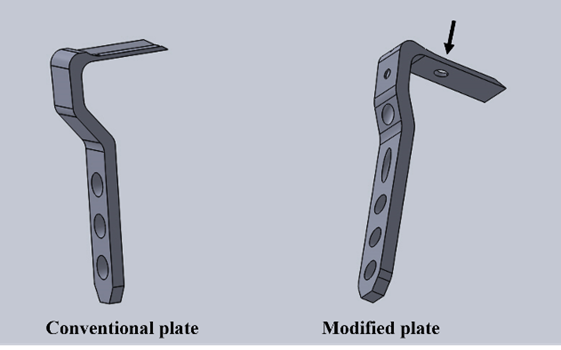
Figure 2-c: A hole was made in the blade to receive the tip of the oblique screw.
The modified plate was made of grade 4 pure titanium designed for medical application. We call it the cannulated interlocking angled plate.
All patients were treated by open reduction of the dysplastic hip, proximal femoral varus osteotomy, and pelvic osteotomy. The varus osteotomy was fixed by the modified plate in all patients. Informed consent was obtained from the patients and their relatives before surgery. The study was app39roved by the institutional review board (IRB).
Surgical technique
The patient was put supine on a radiolucent operative table. After preparation of the affected limb, a bikini incision was used to approach the affected hip. The interval between the iliopsoas and sartorius was developed. The lateral cutaneous nerve of the femur was identified and retracted laterally. The iliopsoas tendon was released. The reflected head of the rectus femoris was disinserted and retracted laterally to expose the anterior part of the capsule, and then a T-shaped incision was made in the capsule to expose the head. The acetabulum was cleaned from its fibrofatty tissue, and the transverse ligament of the acetabulum was incised. The head was then reduced and a capsulorrhaphy was performed. [11, 12] The proximal femur was exposed through a separate incision. A suitable point for entry of the guidewire was marked over the lateral aspect of the proximal femur. The guidewire was inserted through this point into the center of the femoral neck and confirmed on both AP and lateral radiographic projections (Fig. 3-a). Another two wires were inserted at the lesser trochanter level, making an angle equal to the angle of correction (Fig. 3-b). The cannulated seating chisel was used to cut a track for the blade plate by gentle hammering of the chisel over the guidewire (Fig. 3-c). The varus proximal femoral osteotomy was then performed by an oscillating saw along the second and third wires. The wedge of bone with its base medially was removed and the osteotomy surfaces were coopted to correct the deformity. The plate was inserted over the guidewire after removal of the seating chisel (Fig. 3-d). The osteotomy was reduced, and the plate was fixed to the femoral shaft. First, a nonlocking screw was used to produce compression at the site of the osteotomy. Then fixation was completed by the locking screws.
The interfragmentary 3.5-locked screw was taken from the shaft of the plate to the blade in an oblique direction at 30° to give more stability for the plate and prevent backing out of the blade from the neck.
Both anteroposterior and lateral fluoroscopic projections were taken to check the plate position. The stability of fixation was tested by putting the hip in different ranges of movements. Dega pelvic osteotomy was done to correct the acetabular insufficiency (Fig. 3-e). The wound was closed in layers. The average hospital stay was 5 days. Sequential radiographs were obtained postoperatively at 6 weeks, 3 months, 6 months then every year. At the final follow-up, the acetabular index, the neck-shaft angle, and the migration percentages were measured.
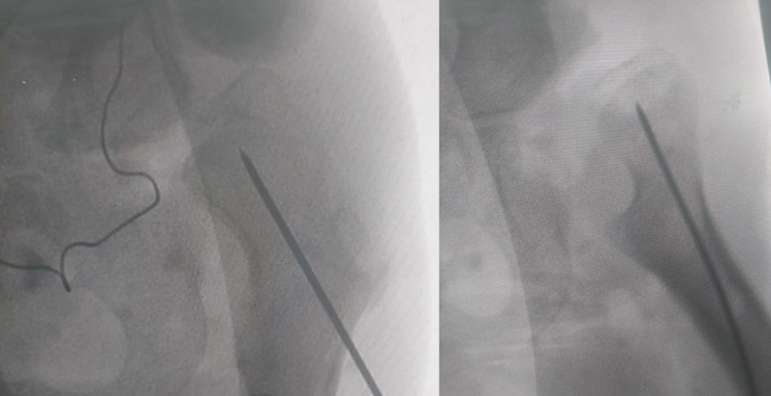
Figure 3-a: The guidewire is inserted in the center of the femoral neck and confirmed on both AP and lateral radiographic projections.
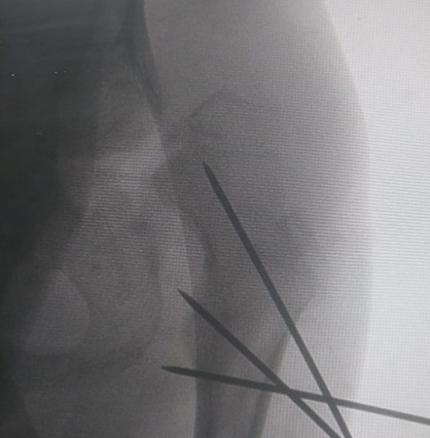
Figure 3-b: Another two wires are inserted at the lesser trochanter level, making an angle equal to the amount of correction.
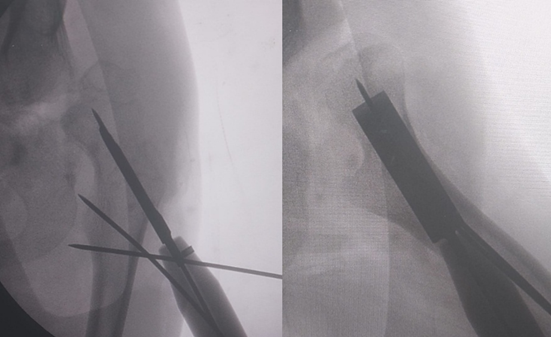
Figure 3-c: The cannulated seating chisel is used to cut a track for the blade plate by the gentle hammering of the chisel over the guidewire.
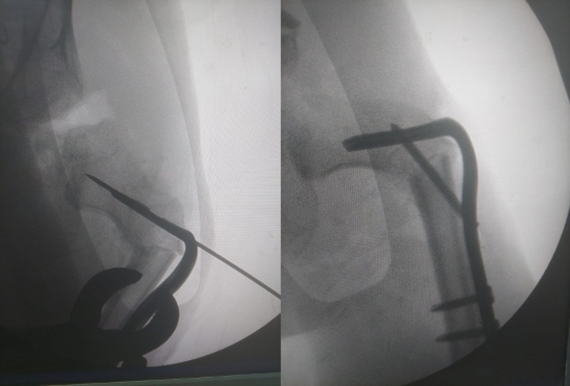
Figure 3-d: The blade plate is inserted over the guidewire and fixed to the shaft. The interfragmentary 3.5 locked screw is taken from the shaft of the plate to the blade in an oblique direction of 30°.
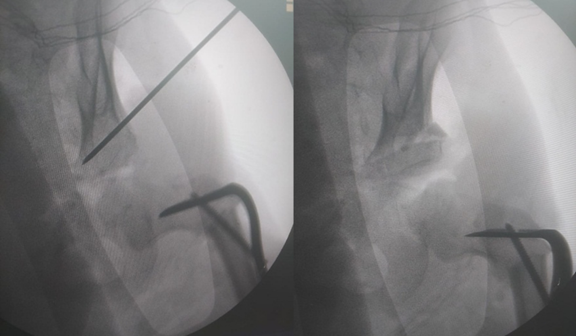
Figure 3-e: Dega pelvic osteotomy is done to correct the acetabular insufficiency.
The operative time ranged from 70 to 120 minutes with an average of 90 minutes. The average follow-up period was 19 months (range, 13 to 42 months). The time of union ranged from 1.5 to 5 months with an average of 3 months (Fig. 4). The mean preoperative NSA was 155.6° and the mean postoperative was 110.6°, with an average reduction of 35.1°.
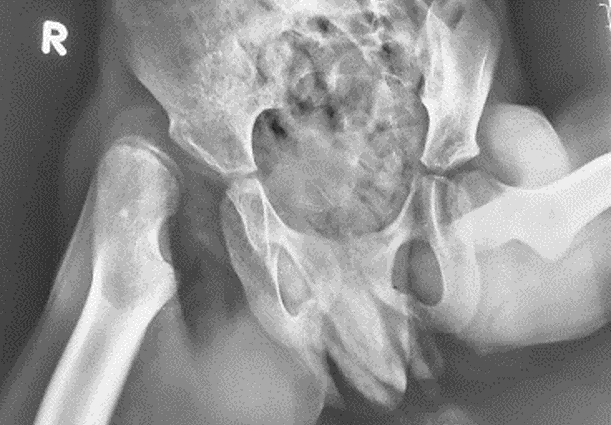
Figure 4-a: 4-year-old male patient with CP presented with paralytic dislocation of the right hip.
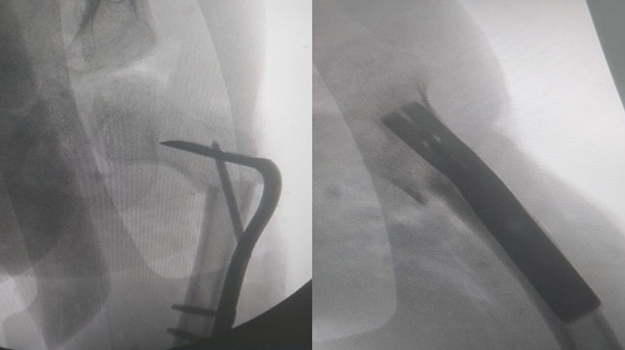
Figure 4-b: He was treated with open reduction, femoral osteotomy, and fixation by the modified plate.
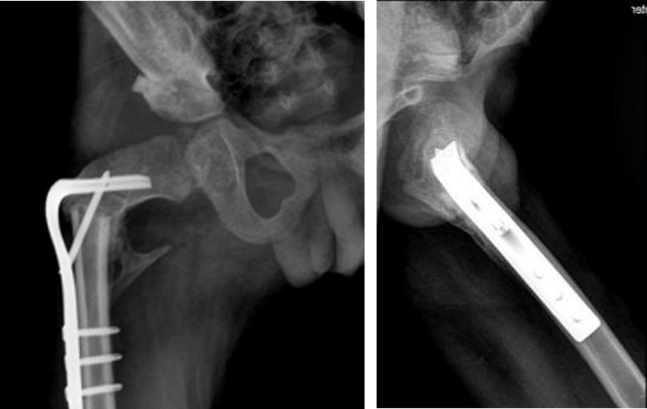
Figure 4-c: The radiographs 3 months after surgery with complete healing of the osteotomy site.
Regarding the AI, the mean reduction was 14.38°, with pre and postoperative means of 38.03° and 23.65° respectively. Also, the MP presented a mean reduction of 79%, with pre and postoperative means of 90% and 11%. respectively. A significant difference was observed between pre and postoperative NSA and AI (p < 0>p < 0>Parameters Preoperative mean Postoperative mean Mean Of reduction P value NSA 155.6° 110.6° 35.1° < 0> AI 38.03° 23.65° 14.38° < 0> MP 90% 11% 79% < 0>
NSA: neck shaft angle, AI: acetabular index, MP: migration percentage.
Table 1: Summary of radiographic indices pre and postoperative with P value.
The gait improved in the ambulant patients. The families reported improvement in the seating position and personal hygiene in all patients. Two cases were complicated by superficial wound infection, and they were treated by local wound care and systemic antibiotics. No cases were complicated by delayed unions, nonunion, skin irritation from the plate, or loss of fixation. There were no revision procedures due to implant-related complications.
The prevalence of paralytic hip dislocation in patients with spastic CP is directly proportional to the degree of functional impairment. Failure to identify this dislocation early may lead to significant pain, pelvic tilt, and spine deformity with severe limitations on the patients’ quality of life. The population-based surveillance program was established in certain countries and resulted in a significant reduction in the incidence of hip dislocation in children with cerebral palsy [13-16].
Early surgical interference will reduce the patient's pain, improve function, and prevent further deterioration of the hip condition. Osteotomy of the proximal femur is an important step in the reconstruction of the dysplastic hip in patients with paralytic disorders [4-6]. The internal fixation device is specially adapted to the osteoporotic bone in patients with neurological diseases. Three systems of fixation are in common use for correction of proximal femoral osteotomy: AO angled blade plate, AO anterior plate, and the LCP (locked compression plate). Each one has its advantages and disadvantages [17-19].
Several studies have supported the use of fixed angle plate in the fixation of the proximal femoral osteotomy [8, 20].
Although good, many complications had been reported with the conventional fixed-angle blade plates. These complications may be early as wrong direction or loosening of the blade within the neck of the femur or late such as delayed union, nonunion, avascular necrosis, backing out of the plate, fractures under the plate, and periarticular osteophytes. These ossifications may result in bone bridges which may cause severe stiffness and deformities [8, 9].
Mal-tracking of the blade in the neck femur is a common complication with the conventional plate. Grant and colleagues described the cannulated blade plate in 1990 to avoid this complication. The guidewire must be inserted properly, and the seating Chesil and the plate will follow it without mal tracking [21, 22].
In this study, we introduced certain modifications for the cannulated angled blade plate to increase its stability for fixation (Table 2).
| Items | Conventional | Modified |
| Profile | 4.5mm | 3.5mm |
| Interfragmentary screw | absent | present |
| 1st angle | 90° | 90° |
| 2nd angle | 42.5° | 20° |
| Screw | 4.5mm | 3.5mm |
| Length of blade | 35, 40, 45, 50mm | 35, 45, 50mm |
| Length of shaft | 73.85mm | 81.82mm |
Table 2: Comparison between conventional and modified angled plate.
The modified plate was used for fixation of proximal femoral varus osteotomy in the surgical management of paralytic hip dislocation in 20 patients. The osteotomy site united in all patients and the average time of union was 3 months. There was a significant reduction in the radiological parameters in all cases postoperatively. The hip joint remained stable throughout the period of follow-up without further dislocation or subluxation (Fig. 5). No cases were complicated by nonunion, backing out of the blade, or implant failure which reflect the stability of the construct. No skin irritation was observed in the trochanteric region from the plate.
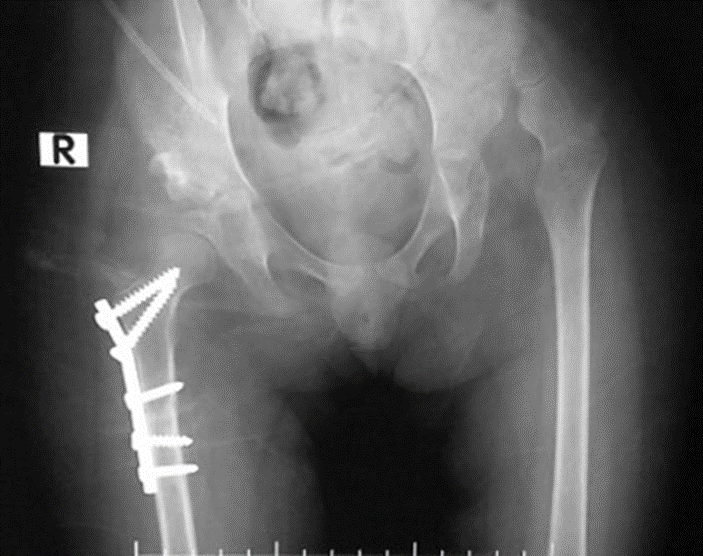
Figure 5-a: 5-year-old girl with myelomeningocele presented by bilateral hip dislocations. The right side was treated surgically before.
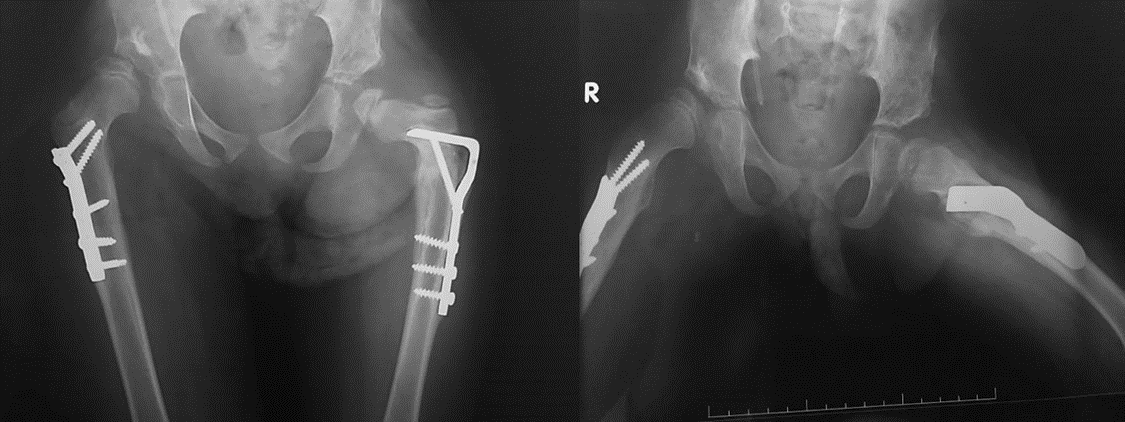
Figure 5-b: The radiographs 6 months after surgical treatment of the left side by pelvic osteotomy, femoral osteotomy, and fixation by the modified angled plate.
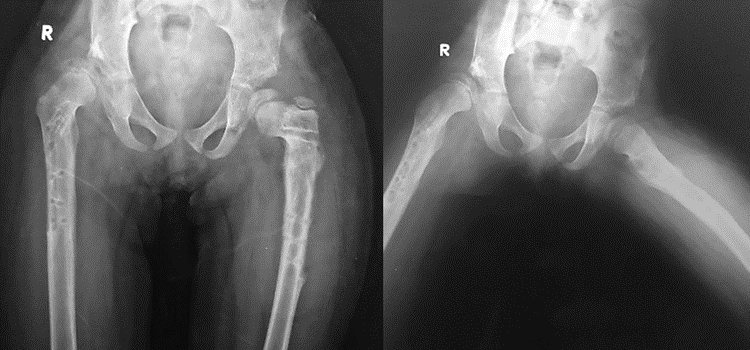
Figure 5-c: The radiographs after removal of the implant 3 years after surgery. The left hip is still reduced and stable.
Because of the poor nutrition state and poor walking ability of children with the paralytic disorder, the bone is usually osteoporotic and the problem of implant failure especially backing out of the plate is common. Several trials were done to increase the degree of fixation stability in those patients. Some authors used the locking plate and others take an interfragmentary screw from proximal to distal fragments outside the plate after proximal femoral varus osteotomy. [8, 19] In this study we designed an interfragmentary 3.5 locked screw from the shaft of the plate to its blade in an oblique direction of 30°. This screw has many advantages as it fixes both the proximal and distal bone fragments to each other and the plate blade. It prevents backing out of the plate. Also, it supports the blade and prevents further varus collapse.
Reduction of the second angle of the plate from 42.5 degrees to 20 degrees decreases the prominence of the plate under the skin and still produces medialization of the distal fragment which is required in such cases.
The new angled plat (cannulated interlocking blade plate 90°) offers great advantages over the conventional plate in terms of easy application, high stability, short operative time, and decreased prominence under the skin. This study's clinical and radiological results favor using this plate in the fixation of proximal femoral osteotomy in paralytic hip dislocation.
Clearly Auctoresonline and particularly Psychology and Mental Health Care Journal is dedicated to improving health care services for individuals and populations. The editorial boards' ability to efficiently recognize and share the global importance of health literacy with a variety of stakeholders. Auctoresonline publishing platform can be used to facilitate of optimal client-based services and should be added to health care professionals' repertoire of evidence-based health care resources.

Journal of Clinical Cardiology and Cardiovascular Intervention The submission and review process was adequate. However I think that the publication total value should have been enlightened in early fases. Thank you for all.

Journal of Women Health Care and Issues By the present mail, I want to say thank to you and tour colleagues for facilitating my published article. Specially thank you for the peer review process, support from the editorial office. I appreciate positively the quality of your journal.
Journal of Clinical Research and Reports I would be very delighted to submit my testimonial regarding the reviewer board and the editorial office. The reviewer board were accurate and helpful regarding any modifications for my manuscript. And the editorial office were very helpful and supportive in contacting and monitoring with any update and offering help. It was my pleasure to contribute with your promising Journal and I am looking forward for more collaboration.

We would like to thank the Journal of Thoracic Disease and Cardiothoracic Surgery because of the services they provided us for our articles. The peer-review process was done in a very excellent time manner, and the opinions of the reviewers helped us to improve our manuscript further. The editorial office had an outstanding correspondence with us and guided us in many ways. During a hard time of the pandemic that is affecting every one of us tremendously, the editorial office helped us make everything easier for publishing scientific work. Hope for a more scientific relationship with your Journal.

The peer-review process which consisted high quality queries on the paper. I did answer six reviewers’ questions and comments before the paper was accepted. The support from the editorial office is excellent.

Journal of Neuroscience and Neurological Surgery. I had the experience of publishing a research article recently. The whole process was simple from submission to publication. The reviewers made specific and valuable recommendations and corrections that improved the quality of my publication. I strongly recommend this Journal.

Dr. Katarzyna Byczkowska My testimonial covering: "The peer review process is quick and effective. The support from the editorial office is very professional and friendly. Quality of the Clinical Cardiology and Cardiovascular Interventions is scientific and publishes ground-breaking research on cardiology that is useful for other professionals in the field.

Thank you most sincerely, with regard to the support you have given in relation to the reviewing process and the processing of my article entitled "Large Cell Neuroendocrine Carcinoma of The Prostate Gland: A Review and Update" for publication in your esteemed Journal, Journal of Cancer Research and Cellular Therapeutics". The editorial team has been very supportive.

Testimony of Journal of Clinical Otorhinolaryngology: work with your Reviews has been a educational and constructive experience. The editorial office were very helpful and supportive. It was a pleasure to contribute to your Journal.

Dr. Bernard Terkimbi Utoo, I am happy to publish my scientific work in Journal of Women Health Care and Issues (JWHCI). The manuscript submission was seamless and peer review process was top notch. I was amazed that 4 reviewers worked on the manuscript which made it a highly technical, standard and excellent quality paper. I appreciate the format and consideration for the APC as well as the speed of publication. It is my pleasure to continue with this scientific relationship with the esteem JWHCI.

This is an acknowledgment for peer reviewers, editorial board of Journal of Clinical Research and Reports. They show a lot of consideration for us as publishers for our research article “Evaluation of the different factors associated with side effects of COVID-19 vaccination on medical students, Mutah university, Al-Karak, Jordan”, in a very professional and easy way. This journal is one of outstanding medical journal.
Dear Hao Jiang, to Journal of Nutrition and Food Processing We greatly appreciate the efficient, professional and rapid processing of our paper by your team. If there is anything else we should do, please do not hesitate to let us know. On behalf of my co-authors, we would like to express our great appreciation to editor and reviewers.

As an author who has recently published in the journal "Brain and Neurological Disorders". I am delighted to provide a testimonial on the peer review process, editorial office support, and the overall quality of the journal. The peer review process at Brain and Neurological Disorders is rigorous and meticulous, ensuring that only high-quality, evidence-based research is published. The reviewers are experts in their fields, and their comments and suggestions were constructive and helped improve the quality of my manuscript. The review process was timely and efficient, with clear communication from the editorial office at each stage. The support from the editorial office was exceptional throughout the entire process. The editorial staff was responsive, professional, and always willing to help. They provided valuable guidance on formatting, structure, and ethical considerations, making the submission process seamless. Moreover, they kept me informed about the status of my manuscript and provided timely updates, which made the process less stressful. The journal Brain and Neurological Disorders is of the highest quality, with a strong focus on publishing cutting-edge research in the field of neurology. The articles published in this journal are well-researched, rigorously peer-reviewed, and written by experts in the field. The journal maintains high standards, ensuring that readers are provided with the most up-to-date and reliable information on brain and neurological disorders. In conclusion, I had a wonderful experience publishing in Brain and Neurological Disorders. The peer review process was thorough, the editorial office provided exceptional support, and the journal's quality is second to none. I would highly recommend this journal to any researcher working in the field of neurology and brain disorders.

Dear Agrippa Hilda, Journal of Neuroscience and Neurological Surgery, Editorial Coordinator, I trust this message finds you well. I want to extend my appreciation for considering my article for publication in your esteemed journal. I am pleased to provide a testimonial regarding the peer review process and the support received from your editorial office. The peer review process for my paper was carried out in a highly professional and thorough manner. The feedback and comments provided by the authors were constructive and very useful in improving the quality of the manuscript. This rigorous assessment process undoubtedly contributes to the high standards maintained by your journal.

International Journal of Clinical Case Reports and Reviews. I strongly recommend to consider submitting your work to this high-quality journal. The support and availability of the Editorial staff is outstanding and the review process was both efficient and rigorous.

Thank you very much for publishing my Research Article titled “Comparing Treatment Outcome Of Allergic Rhinitis Patients After Using Fluticasone Nasal Spray And Nasal Douching" in the Journal of Clinical Otorhinolaryngology. As Medical Professionals we are immensely benefited from study of various informative Articles and Papers published in this high quality Journal. I look forward to enriching my knowledge by regular study of the Journal and contribute my future work in the field of ENT through the Journal for use by the medical fraternity. The support from the Editorial office was excellent and very prompt. I also welcome the comments received from the readers of my Research Article.

Dear Erica Kelsey, Editorial Coordinator of Cancer Research and Cellular Therapeutics Our team is very satisfied with the processing of our paper by your journal. That was fast, efficient, rigorous, but without unnecessary complications. We appreciated the very short time between the submission of the paper and its publication on line on your site.

I am very glad to say that the peer review process is very successful and fast and support from the Editorial Office. Therefore, I would like to continue our scientific relationship for a long time. And I especially thank you for your kindly attention towards my article. Have a good day!

"We recently published an article entitled “Influence of beta-Cyclodextrins upon the Degradation of Carbofuran Derivatives under Alkaline Conditions" in the Journal of “Pesticides and Biofertilizers” to show that the cyclodextrins protect the carbamates increasing their half-life time in the presence of basic conditions This will be very helpful to understand carbofuran behaviour in the analytical, agro-environmental and food areas. We greatly appreciated the interaction with the editor and the editorial team; we were particularly well accompanied during the course of the revision process, since all various steps towards publication were short and without delay".

I would like to express my gratitude towards you process of article review and submission. I found this to be very fair and expedient. Your follow up has been excellent. I have many publications in national and international journal and your process has been one of the best so far. Keep up the great work.

We are grateful for this opportunity to provide a glowing recommendation to the Journal of Psychiatry and Psychotherapy. We found that the editorial team were very supportive, helpful, kept us abreast of timelines and over all very professional in nature. The peer review process was rigorous, efficient and constructive that really enhanced our article submission. The experience with this journal remains one of our best ever and we look forward to providing future submissions in the near future.

I am very pleased to serve as EBM of the journal, I hope many years of my experience in stem cells can help the journal from one way or another. As we know, stem cells hold great potential for regenerative medicine, which are mostly used to promote the repair response of diseased, dysfunctional or injured tissue using stem cells or their derivatives. I think Stem Cell Research and Therapeutics International is a great platform to publish and share the understanding towards the biology and translational or clinical application of stem cells.

I would like to give my testimony in the support I have got by the peer review process and to support the editorial office where they were of asset to support young author like me to be encouraged to publish their work in your respected journal and globalize and share knowledge across the globe. I really give my great gratitude to your journal and the peer review including the editorial office.

I am delighted to publish our manuscript entitled "A Perspective on Cocaine Induced Stroke - Its Mechanisms and Management" in the Journal of Neuroscience and Neurological Surgery. The peer review process, support from the editorial office, and quality of the journal are excellent. The manuscripts published are of high quality and of excellent scientific value. I recommend this journal very much to colleagues.

Dr.Tania Muñoz, My experience as researcher and author of a review article in The Journal Clinical Cardiology and Interventions has been very enriching and stimulating. The editorial team is excellent, performs its work with absolute responsibility and delivery. They are proactive, dynamic and receptive to all proposals. Supporting at all times the vast universe of authors who choose them as an option for publication. The team of review specialists, members of the editorial board, are brilliant professionals, with remarkable performance in medical research and scientific methodology. Together they form a frontline team that consolidates the JCCI as a magnificent option for the publication and review of high-level medical articles and broad collective interest. I am honored to be able to share my review article and open to receive all your comments.

“The peer review process of JPMHC is quick and effective. Authors are benefited by good and professional reviewers with huge experience in the field of psychology and mental health. The support from the editorial office is very professional. People to contact to are friendly and happy to help and assist any query authors might have. Quality of the Journal is scientific and publishes ground-breaking research on mental health that is useful for other professionals in the field”.

Dear editorial department: On behalf of our team, I hereby certify the reliability and superiority of the International Journal of Clinical Case Reports and Reviews in the peer review process, editorial support, and journal quality. Firstly, the peer review process of the International Journal of Clinical Case Reports and Reviews is rigorous, fair, transparent, fast, and of high quality. The editorial department invites experts from relevant fields as anonymous reviewers to review all submitted manuscripts. These experts have rich academic backgrounds and experience, and can accurately evaluate the academic quality, originality, and suitability of manuscripts. The editorial department is committed to ensuring the rigor of the peer review process, while also making every effort to ensure a fast review cycle to meet the needs of authors and the academic community. Secondly, the editorial team of the International Journal of Clinical Case Reports and Reviews is composed of a group of senior scholars and professionals with rich experience and professional knowledge in related fields. The editorial department is committed to assisting authors in improving their manuscripts, ensuring their academic accuracy, clarity, and completeness. Editors actively collaborate with authors, providing useful suggestions and feedback to promote the improvement and development of the manuscript. We believe that the support of the editorial department is one of the key factors in ensuring the quality of the journal. Finally, the International Journal of Clinical Case Reports and Reviews is renowned for its high- quality articles and strict academic standards. The editorial department is committed to publishing innovative and academically valuable research results to promote the development and progress of related fields. The International Journal of Clinical Case Reports and Reviews is reasonably priced and ensures excellent service and quality ratio, allowing authors to obtain high-level academic publishing opportunities in an affordable manner. I hereby solemnly declare that the International Journal of Clinical Case Reports and Reviews has a high level of credibility and superiority in terms of peer review process, editorial support, reasonable fees, and journal quality. Sincerely, Rui Tao.

Clinical Cardiology and Cardiovascular Interventions I testity the covering of the peer review process, support from the editorial office, and quality of the journal.

Clinical Cardiology and Cardiovascular Interventions, we deeply appreciate the interest shown in our work and its publication. It has been a true pleasure to collaborate with you. The peer review process, as well as the support provided by the editorial office, have been exceptional, and the quality of the journal is very high, which was a determining factor in our decision to publish with you.
The peer reviewers process is quick and effective, the supports from editorial office is excellent, the quality of journal is high. I would like to collabroate with Internatioanl journal of Clinical Case Reports and Reviews journal clinically in the future time.

Clinical Cardiology and Cardiovascular Interventions, I would like to express my sincerest gratitude for the trust placed in our team for the publication in your journal. It has been a true pleasure to collaborate with you on this project. I am pleased to inform you that both the peer review process and the attention from the editorial coordination have been excellent. Your team has worked with dedication and professionalism to ensure that your publication meets the highest standards of quality. We are confident that this collaboration will result in mutual success, and we are eager to see the fruits of this shared effort.

Dear Dr. Jessica Magne, Editorial Coordinator 0f Clinical Cardiology and Cardiovascular Interventions, I hope this message finds you well. I want to express my utmost gratitude for your excellent work and for the dedication and speed in the publication process of my article titled "Navigating Innovation: Qualitative Insights on Using Technology for Health Education in Acute Coronary Syndrome Patients." I am very satisfied with the peer review process, the support from the editorial office, and the quality of the journal. I hope we can maintain our scientific relationship in the long term.
Dear Monica Gissare, - Editorial Coordinator of Nutrition and Food Processing. ¨My testimony with you is truly professional, with a positive response regarding the follow-up of the article and its review, you took into account my qualities and the importance of the topic¨.

Dear Dr. Jessica Magne, Editorial Coordinator 0f Clinical Cardiology and Cardiovascular Interventions, The review process for the article “The Handling of Anti-aggregants and Anticoagulants in the Oncologic Heart Patient Submitted to Surgery” was extremely rigorous and detailed. From the initial submission to the final acceptance, the editorial team at the “Journal of Clinical Cardiology and Cardiovascular Interventions” demonstrated a high level of professionalism and dedication. The reviewers provided constructive and detailed feedback, which was essential for improving the quality of our work. Communication was always clear and efficient, ensuring that all our questions were promptly addressed. The quality of the “Journal of Clinical Cardiology and Cardiovascular Interventions” is undeniable. It is a peer-reviewed, open-access publication dedicated exclusively to disseminating high-quality research in the field of clinical cardiology and cardiovascular interventions. The journal's impact factor is currently under evaluation, and it is indexed in reputable databases, which further reinforces its credibility and relevance in the scientific field. I highly recommend this journal to researchers looking for a reputable platform to publish their studies.

Dear Editorial Coordinator of the Journal of Nutrition and Food Processing! "I would like to thank the Journal of Nutrition and Food Processing for including and publishing my article. The peer review process was very quick, movement and precise. The Editorial Board has done an extremely conscientious job with much help, valuable comments and advices. I find the journal very valuable from a professional point of view, thank you very much for allowing me to be part of it and I would like to participate in the future!”

Dealing with The Journal of Neurology and Neurological Surgery was very smooth and comprehensive. The office staff took time to address my needs and the response from editors and the office was prompt and fair. I certainly hope to publish with this journal again.Their professionalism is apparent and more than satisfactory. Susan Weiner

My Testimonial Covering as fellowing: Lin-Show Chin. The peer reviewers process is quick and effective, the supports from editorial office is excellent, the quality of journal is high. I would like to collabroate with Internatioanl journal of Clinical Case Reports and Reviews.

My experience publishing in Psychology and Mental Health Care was exceptional. The peer review process was rigorous and constructive, with reviewers providing valuable insights that helped enhance the quality of our work. The editorial team was highly supportive and responsive, making the submission process smooth and efficient. The journal's commitment to high standards and academic rigor makes it a respected platform for quality research. I am grateful for the opportunity to publish in such a reputable journal.
My experience publishing in International Journal of Clinical Case Reports and Reviews was exceptional. I Come forth to Provide a Testimonial Covering the Peer Review Process and the editorial office for the Professional and Impartial Evaluation of the Manuscript.

I would like to offer my testimony in the support. I have received through the peer review process and support the editorial office where they are to support young authors like me, encourage them to publish their work in your esteemed journals, and globalize and share knowledge globally. I really appreciate your journal, peer review, and editorial office.
Dear Agrippa Hilda- Editorial Coordinator of Journal of Neuroscience and Neurological Surgery, "The peer review process was very quick and of high quality, which can also be seen in the articles in the journal. The collaboration with the editorial office was very good."

I would like to express my sincere gratitude for the support and efficiency provided by the editorial office throughout the publication process of my article, “Delayed Vulvar Metastases from Rectal Carcinoma: A Case Report.” I greatly appreciate the assistance and guidance I received from your team, which made the entire process smooth and efficient. The peer review process was thorough and constructive, contributing to the overall quality of the final article. I am very grateful for the high level of professionalism and commitment shown by the editorial staff, and I look forward to maintaining a long-term collaboration with the International Journal of Clinical Case Reports and Reviews.
To Dear Erin Aust, I would like to express my heartfelt appreciation for the opportunity to have my work published in this esteemed journal. The entire publication process was smooth and well-organized, and I am extremely satisfied with the final result. The Editorial Team demonstrated the utmost professionalism, providing prompt and insightful feedback throughout the review process. Their clear communication and constructive suggestions were invaluable in enhancing my manuscript, and their meticulous attention to detail and dedication to quality are truly commendable. Additionally, the support from the Editorial Office was exceptional. From the initial submission to the final publication, I was guided through every step of the process with great care and professionalism. The team's responsiveness and assistance made the entire experience both easy and stress-free. I am also deeply impressed by the quality and reputation of the journal. It is an honor to have my research featured in such a respected publication, and I am confident that it will make a meaningful contribution to the field.

"I am grateful for the opportunity of contributing to [International Journal of Clinical Case Reports and Reviews] and for the rigorous review process that enhances the quality of research published in your esteemed journal. I sincerely appreciate the time and effort of your team who have dedicatedly helped me in improvising changes and modifying my manuscript. The insightful comments and constructive feedback provided have been invaluable in refining and strengthening my work".

I thank the ‘Journal of Clinical Research and Reports’ for accepting this article for publication. This is a rigorously peer reviewed journal which is on all major global scientific data bases. I note the review process was prompt, thorough and professionally critical. It gave us an insight into a number of important scientific/statistical issues. The review prompted us to review the relevant literature again and look at the limitations of the study. The peer reviewers were open, clear in the instructions and the editorial team was very prompt in their communication. This journal certainly publishes quality research articles. I would recommend the journal for any future publications.

Dear Jessica Magne, with gratitude for the joint work. Fast process of receiving and processing the submitted scientific materials in “Clinical Cardiology and Cardiovascular Interventions”. High level of competence of the editors with clear and correct recommendations and ideas for enriching the article.

We found the peer review process quick and positive in its input. The support from the editorial officer has been very agile, always with the intention of improving the article and taking into account our subsequent corrections.

My article, titled 'No Way Out of the Smartphone Epidemic Without Considering the Insights of Brain Research,' has been republished in the International Journal of Clinical Case Reports and Reviews. The review process was seamless and professional, with the editors being both friendly and supportive. I am deeply grateful for their efforts.
To Dear Erin Aust – Editorial Coordinator of Journal of General Medicine and Clinical Practice! I declare that I am absolutely satisfied with your work carried out with great competence in following the manuscript during the various stages from its receipt, during the revision process to the final acceptance for publication. Thank Prof. Elvira Farina

Dear Jessica, and the super professional team of the ‘Clinical Cardiology and Cardiovascular Interventions’ I am sincerely grateful to the coordinated work of the journal team for the no problem with the submission of my manuscript: “Cardiometabolic Disorders in A Pregnant Woman with Severe Preeclampsia on the Background of Morbid Obesity (Case Report).” The review process by 5 experts was fast, and the comments were professional, which made it more specific and academic, and the process of publication and presentation of the article was excellent. I recommend that my colleagues publish articles in this journal, and I am interested in further scientific cooperation. Sincerely and best wishes, Dr. Oleg Golyanovskiy.

Dear Ashley Rosa, Editorial Coordinator of the journal - Psychology and Mental Health Care. " The process of obtaining publication of my article in the Psychology and Mental Health Journal was positive in all areas. The peer review process resulted in a number of valuable comments, the editorial process was collaborative and timely, and the quality of this journal has been quickly noticed, resulting in alternative journals contacting me to publish with them." Warm regards, Susan Anne Smith, PhD. Australian Breastfeeding Association.

Dear Jessica Magne, Editorial Coordinator, Clinical Cardiology and Cardiovascular Interventions, Auctores Publishing LLC. I appreciate the journal (JCCI) editorial office support, the entire team leads were always ready to help, not only on technical front but also on thorough process. Also, I should thank dear reviewers’ attention to detail and creative approach to teach me and bring new insights by their comments. Surely, more discussions and introduction of other hemodynamic devices would provide better prevention and management of shock states. Your efforts and dedication in presenting educational materials in this journal are commendable. Best wishes from, Farahnaz Fallahian.
Dear Maria Emerson, Editorial Coordinator, International Journal of Clinical Case Reports and Reviews, Auctores Publishing LLC. I am delighted to have published our manuscript, "Acute Colonic Pseudo-Obstruction (ACPO): A rare but serious complication following caesarean section." I want to thank the editorial team, especially Maria Emerson, for their prompt review of the manuscript, quick responses to queries, and overall support. Yours sincerely Dr. Victor Olagundoye.

Dear Ashley Rosa, Editorial Coordinator, International Journal of Clinical Case Reports and Reviews. Many thanks for publishing this manuscript after I lost confidence the editors were most helpful, more than other journals Best wishes from, Susan Anne Smith, PhD. Australian Breastfeeding Association.

Dear Agrippa Hilda, Editorial Coordinator, Journal of Neuroscience and Neurological Surgery. The entire process including article submission, review, revision, and publication was extremely easy. The journal editor was prompt and helpful, and the reviewers contributed to the quality of the paper. Thank you so much! Eric Nussbaum, MD
Dr Hala Al Shaikh This is to acknowledge that the peer review process for the article ’ A Novel Gnrh1 Gene Mutation in Four Omani Male Siblings, Presentation and Management ’ sent to the International Journal of Clinical Case Reports and Reviews was quick and smooth. The editorial office was prompt with easy communication.

Dear Erin Aust, Editorial Coordinator, Journal of General Medicine and Clinical Practice. We are pleased to share our experience with the “Journal of General Medicine and Clinical Practice”, following the successful publication of our article. The peer review process was thorough and constructive, helping to improve the clarity and quality of the manuscript. We are especially thankful to Ms. Erin Aust, the Editorial Coordinator, for her prompt communication and continuous support throughout the process. Her professionalism ensured a smooth and efficient publication experience. The journal upholds high editorial standards, and we highly recommend it to fellow researchers seeking a credible platform for their work. Best wishes By, Dr. Rakhi Mishra.

Dear Jessica Magne, Editorial Coordinator, Clinical Cardiology and Cardiovascular Interventions, Auctores Publishing LLC. The peer review process of the journal of Clinical Cardiology and Cardiovascular Interventions was excellent and fast, as was the support of the editorial office and the quality of the journal. Kind regards Walter F. Riesen Prof. Dr. Dr. h.c. Walter F. Riesen.

Dear Ashley Rosa, Editorial Coordinator, International Journal of Clinical Case Reports and Reviews, Auctores Publishing LLC. Thank you for publishing our article, Exploring Clozapine's Efficacy in Managing Aggression: A Multiple Single-Case Study in Forensic Psychiatry in the international journal of clinical case reports and reviews. We found the peer review process very professional and efficient. The comments were constructive, and the whole process was efficient. On behalf of the co-authors, I would like to thank you for publishing this article. With regards, Dr. Jelle R. Lettinga.

Dear Clarissa Eric, Editorial Coordinator, Journal of Clinical Case Reports and Studies, I would like to express my deep admiration for the exceptional professionalism demonstrated by your journal. I am thoroughly impressed by the speed of the editorial process, the substantive and insightful reviews, and the meticulous preparation of the manuscript for publication. Additionally, I greatly appreciate the courteous and immediate responses from your editorial office to all my inquiries. Best Regards, Dariusz Ziora

Dear Chrystine Mejia, Editorial Coordinator, Journal of Neurodegeneration and Neurorehabilitation, Auctores Publishing LLC, We would like to thank the editorial team for the smooth and high-quality communication leading up to the publication of our article in the Journal of Neurodegeneration and Neurorehabilitation. The reviewers have extensive knowledge in the field, and their relevant questions helped to add value to our publication. Kind regards, Dr. Ravi Shrivastava.

Dear Clarissa Eric, Editorial Coordinator, Journal of Clinical Case Reports and Studies, Auctores Publishing LLC, USA Office: +1-(302)-520-2644. I would like to express my sincere appreciation for the efficient and professional handling of my case report by the ‘Journal of Clinical Case Reports and Studies’. The peer review process was not only fast but also highly constructive—the reviewers’ comments were clear, relevant, and greatly helped me improve the quality and clarity of my manuscript. I also received excellent support from the editorial office throughout the process. Communication was smooth and timely, and I felt well guided at every stage, from submission to publication. The overall quality and rigor of the journal are truly commendable. I am pleased to have published my work with Journal of Clinical Case Reports and Studies, and I look forward to future opportunities for collaboration. Sincerely, Aline Tollet, UCLouvain.

Dear Ms. Mayra Duenas, Editorial Coordinator, International Journal of Clinical Case Reports and Reviews. “The International Journal of Clinical Case Reports and Reviews represented the “ideal house” to share with the research community a first experience with the use of the Simeox device for speech rehabilitation. High scientific reputation and attractive website communication were first determinants for the selection of this Journal, and the following submission process exceeded expectations: fast but highly professional peer review, great support by the editorial office, elegant graphic layout. Exactly what a dynamic research team - also composed by allied professionals - needs!" From, Chiara Beccaluva, PT - Italy.

Dear Maria Emerson, Editorial Coordinator, we have deeply appreciated the professionalism demonstrated by the International Journal of Clinical Case Reports and Reviews. The reviewers have extensive knowledge of our field and have been very efficient and fast in supporting the process. I am really looking forward to further collaboration. Thanks. Best regards, Dr. Claudio Ligresti
Dear Chrystine Mejia, Editorial Coordinator, Journal of Neurodegeneration and Neurorehabilitation. “The peer review process was efficient and constructive, and the editorial office provided excellent communication and support throughout. The journal ensures scientific rigor and high editorial standards, while also offering a smooth and timely publication process. We sincerely appreciate the work of the editorial team in facilitating the dissemination of innovative approaches such as the Bonori Method.” Best regards, Dr. Giselle Pentón-Rol.
